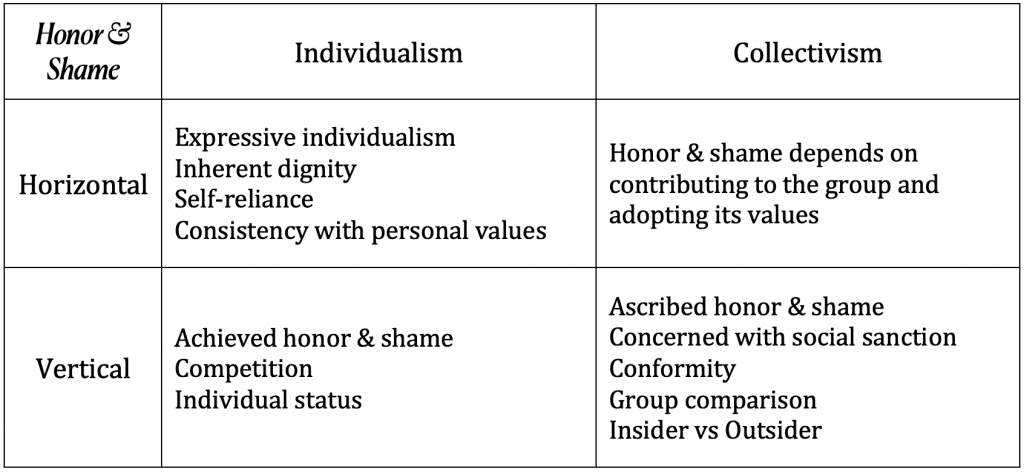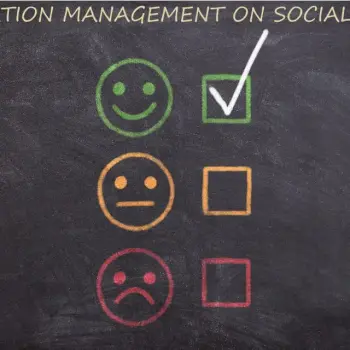The previous post introduced two categories important for understanding more specifically how individualism and collectivism in various societies. What scholars call “horizontal” and “vertical” orientations also intersect with individualism and collectivism.
The chart below grossly oversimplifies four dynamics that potentially emerge across cultures. It serves merely as a reminder rather than a well-rounded description.

In this post, we consider possible implications for better understanding honor and shame. Why do this mental work? By understanding such cultural nuances, we can do two things.
(1) We can discern how people understand the world and its meaning. Accordingly, we can identify potential obstacles or idols related to honor and shame.
(2) We can consider promising approaches to sharing the gospel and serving people such that they can grasp God’s perspective about what is honorable and shameful.
What follows is a spattering of ideas to catalyze further reflection and conversation. I’m eager to hear your ideas.
Horizontal Individualism (HI)
From where does an HI amass honor or shame? This is where we find greater stress on expressive individualism. One’s value is rooted in personal uniqueness. Expressing one’s “authentic self” is praiseworthy. This orientation will most frequently speak of “dignity,” not “honor,” since the latter requires one to care about the opinions of a group (or at least some other person). It is shameful to offend or disregard another’s sense of identity.
I’d suspect a HI-culture would likely be a “loose culture,” in which society’s social norms are only loosely enforced. Accordingly, few behaviors will incur public shaming aside from those that transgress the norms of equality and individualism.
Finally, a person feels honor or shame based on whether they behave consistently with personal goals and values. Thus, one’s sense of honor or shame doesn’t as strongly depend on receiving recognition by others for outperforming one’s peers. More emphasis is on self-sufficiency or self-reliance, but not necessarily self-exaltation (i.e., achieving more than others).

Vertical Individualism (VI)
VI-contexts (e.g., America, Canada, England) pursue “achieved honor” above “ascribed honor.” Naturally, one is most concerned about shame that is “achieved” (i.e., failure or lack of success), though VI’s are not entirely indifferent to “low-status” labels (e.g., poor, uneducated, “redneck”). With loose group identities, VIs are more eager to assert their status to strangers than HCs or VCs.
One researcher adds another interesting tidbit:
Responses to receiving disrespectful service also reflect culturally distinct power concepts and norms. For people who are high (versus low) in a VI cultural orientation, and thus who have a personalized concept of power, receiving disrespectful service from a low-ranking person such as a front-desk receptionist is more likely to be seen as a threat to one’s personal status and power.
This experience can therefore trigger negative affective responses as well as efforts to restore one’s power through status consumption. However, receiving disrespectful service from a high-ranking person (e.g., hotel vice-president) does not necessarily implicate one’s personal status and could instead trigger deferential responses from people high in VI.[1]
Competition and comparison are integral for gaining personal honor or shame. Who has better grades? A higher income? Who ranks above or lower than whom? Ambition centers on the individual more than one’s group. In short, honor is frequently measured in relative terms (e.g., “second place is the first loser”).
Individuals use social media to manage their social persona. Impression management can be an all-consuming task. In cultures with a VI orientation, there is a danger of stressing fame over honor-as-moral-emotion. (This is not surprising since viewing honor as a moral emotion is premised on the idea that morality entails conforming to social norms.) Thus, as Andy Crouch suggests, America has slowly become a “fame-shame” culture.
Vertical Collectivism (VC)
VCs give greater weight to ascribed honor than do VI’s. Therefore, gender, position, and family name either privilege or hinder people’s pursuit of status. In this context, the relative status of the group is prioritized above that of the individual. Naturally, symbolism is important. Following tradition matters. Symbols of honor or symbolic actions serve as markers of group identity. Not to bear such symbols could be regarded as shameful.
Frequently “tight cultures,” people are conscious of avoiding social sanction. Non-conformity disgraces individuals. Hierarchy is valued and expected. Disrespecting authorities is shameful.
Finally, people lay greater stress on honor-as-moral-emotion (e.g., Confucianism). One could describe China and flesh out much of what characterizes VC cultures.
Horizontal Collectivism (HC)
This category presents a unique challenge. While identifying what constitutes something honorable or shameful is doable, a person finds it difficult to locate a precise exemplar. As I’ve surveyed the research, scholars can hardly agree about what culture deserves the label. One could say that a culture is more horizontal and collectivistic than other contexts, but that is not the same as being an HC culture.
I see HCs as somewhat utopian in nature. In this setting, honor is gained through one’s contribution to the group and its values. Such people affirm the equality of individuals yet see themselves as interdependent. Generosity and service fuel a sense that my wellbeing is bound up in our wellbeing.
One writer says:
Vertical individualists tend to view power in personalized terms: Power is a tool to advance their personal status and prestige. On the other hand, horizontal collectivists tend to conceptualize power in socialized terms: Power is a means to benefit and help others. [2]
An HC culture seems to fit Paul’s body analogy. The various members are interdependent, yet each makes a unique and valued contribution.
[1] Sharon Shavitt and Hyewon Cho. “Culture and Consumer Behavior: The Role of Horizontal and Vertical Cultural Factors.” Curr Opin Psychol 8 (2016 April): 149–154.
[2] Ibid.














